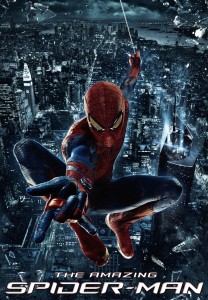Spider-man’s Self-Awareness is AMAZING
 “It’s said there are only 10 plots in all of fiction, but I believe there’s only one: ‘Who am I?'”
“It’s said there are only 10 plots in all of fiction, but I believe there’s only one: ‘Who am I?'”
This daring assertion crops up in The Amazing Spider-man, courtesy of one of Peter Parker’s high school teachers at Midtown High. For everyone jonesing for a “new” story amidst the miasma of franchise-filled entertainment, this might sound discouraging. It doesn’t have to be, however, and part of that notion is the key premise upon which Cinemagogue is built. Naturally, it made this reviewer giddy as a Spider-powered schoolboy when it turned into a key piece of dialogue in this film.
Author Kurt Vonnegut once said something very similar, although his summary wasn’t “who am I?” but rather “man in a hole”. My only problem with both of these options is that – although VERY close to the mark – they are ultimately anthropocentric (man-centered) instead of theocentric (God-centered). I wrote about this idea in an article for EchoHub (formerly Collide Magazine):
Because our media centers overflow with variations on the theme, we make absurd statements such as “Hollywood is out of ideas.” Let’s be fair: Hollywood never had any ideas. In a culture where narrative hunger is better rationed, folks join the narrative dance as teller or listener, waltzing in the craft, conflict, and climax of tales that point to our design and our Designer. We, however, stare through insatiable, jaded eyes and lament—like King Solomon—that there is nothing new under the sun.
“…the eye is not satisfied with seeing, nor the ear filled with hearing. What has been is what will be, and what has been done is what will be done, and there is nothing new under the sun. Is there a thing of which it is said, ‘See, this is new’? It has been already in the ages before us.” —Ecclesiastes 1:8-11,15
Recurring themes needn’t be a source of grief. There may be sadness and boredom if our goal is merely story, but there is joy if reflecting the Designer makes the goal about giving glory. The key is in identifying pieces of the metanarrative, seeing where themes are shared, and where these fit into the frame story of our Designer.
You can read the full article HERE.
 As I mentioned in the third part of our Film & Theology video series, Bugs Bunny in a dress is still Bugs Bunny. The truth is, we LIKE to be fooled, like dopey old Elmer Fudd, into thinking something “new” is standing before us… instead of being honest with ourselves and finding contentment with the reality that the core is ultimately the same central theme. Just because some of us spy the Bunny ears doesn’t mean we have to lament.
As I mentioned in the third part of our Film & Theology video series, Bugs Bunny in a dress is still Bugs Bunny. The truth is, we LIKE to be fooled, like dopey old Elmer Fudd, into thinking something “new” is standing before us… instead of being honest with ourselves and finding contentment with the reality that the core is ultimately the same central theme. Just because some of us spy the Bunny ears doesn’t mean we have to lament.
Think of it like fresh baked bread: a loaf isn’t a “new” thing, but when it just came out of the oven fresh, it smells wonderful. We should want fresh stories, and not get overly hung up on “new”. Batman is Zorro, The Matrix is Dark City (and like every 10th episode of The Twilight Zone), 10 Things I Hate about You is The Taming of the Shrew, and The Social Network might just be our generation’s Citizen Kane. Just because we put different names to the same archetypes and the same human struggles doesn’t make it something “new”. Context – time, place, and nuance – may, however, make it “fresh”. Maybe the problem isn’t that the 4,739th story we engaged seems a lot like story 3,635. Maybe we’ve become narrative gluttons and jaded. Maybe we need to go play outside for a while and come back to stories when we can appreciate a fresh offering.
Ultimately, ALL of our stories are remakes and reboots because that’s what WE are: image and likeness of Adam over and over again grasping at a greater image because ultimately we were cast in the likeness of the ultimate storyteller. “Who am I?” indeed. Spider-man’s fresh installment is self aware of this, and that’s what truly makes it amazing.



YES! I just attempted to have this conversation with my sister…and let’s just say it didn’t get very far. I like your point about bugs bunny, a great example!
Thanks for finding something good to say about the reboot.
For me, the new film was a mixed bag.
The Lizard disappointed, and not just because of the questionable 3D effects. No, he lost his tale—the Jekyll/Hyde story that made him compelling. Other than a weak scene that seemed more like delusion than struggle, Dr. Connors just embraced his inner lizard. Even the good he did at the end (catching Peter) seemed more like the instinctual action that drove much of the films plot. Humans struggle, and often it’s the struggle that’s worth saving.
Still, although I missed the classic Spidey tagline, I appreciated the attempt to make us think more deeply about the demands of great power. The idea is still there but in a different wording so that it can’t as easily be skim-viewed. What responsibility is demanded of those made in the image of the creator of all worlds? What about those fill with great power by a God of grace?
Thanks again for your work.